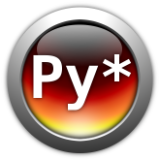python¶
What is python?¶
Python is a general purpose, dynamically-typed, strongly-typed, interpreted computer programming language.
Why do I need python?¶
Well, this is a Python progammming workshop!
Get python!¶
windows¶
- Go to http://python.org/download/ and download the latest version of Python 2.7 (2.7.1 at the time of writing). Unless you know otherwise, get the “Windows Installer” version, and not the “Windows X86-64 Installer” version.
- Start up a command prompt by clicking on the Start menu, clicking the Run... option, typing cmd, and hitting enter. If you are using Windows Vista, you should click on the Start menu, type cmd into the Search field directly above the Start menu button, and click on cmd in the search results above the Search field.
Test your Python install by typing \Python27\python.exe and hitting enter. You should see something like:
Python 2.7.1 (r271:86832, ...) on win32
Type "help", "copyright", "credits" or "license" for more information.
>>>
To exit the Python prompt, type exit() and press Enter. This will take you back to the Windows command prompt.
We also would like to make sure our python is available from the msys/mgit/mingw cli. After starting up msys/mgit:
$ echo '#!/bin/sh' > /bin/python
$ echo 'C:/Python27/python.exe $*' >> /bin/python
$ echo 'export PATH=$PATH:/c/Python27/Scripts' > ~/.profile
$ source ~/.profile
From here on, if you are in the msys/mgit/mingw cli, you can type python to get a python prompt, should you need one!
Mac OSX¶
OS X ships with Python installed, so the goal of this page is to make sure you can start a Terminal and run Python from the command line.
Start up a Terminal. You can find the Terminal application through Spotlight, or navigate to Applications/Utilities/Terminal
Test your Python install at the command prompt. Type python and hit enter. You should see something like:
Python 2.6.1 (r261:67515, Feb 11 2010, 00:51:29) [GCC 4.2.1 (Apple Inc. build 5646)] on darwin Type "help", "copyright", "credits" or "license" for more information. >>>
Linux¶
Linux ships with Python installed, so the goal of this page is to make sure you can start a terminal and run Python from the command line.
Start up a terminal. You can find the Terminal application at Applications/Accessories/Terminal, or it may already be on your menu bar.
Test your Python install at the command prompt. Type python and hit enter. You should see something like:
Python 2.5.2 (r252:60911, Jan 24 2010, 17:44:40) [GCC 4.3.2] on linux2 Type "help", "copyright", "credits" or "license" for more information. >>>
To exit the Python prompt, type exit() and press Enter. This will take you back to the Terminal command prompt.
Verify It Works!¶
After install, show your guide that use can start up python. You should see something like:
Python 2.6.1 (r261:67515, Feb 11 2010, 00:51:29)
[GCC 4.2.1 (Apple Inc. build 5646)] on darwin
Type "help", "copyright", "credits" or "license" for more information.
>>>
Type exit() to return to your terminal/shell. Don’t worry if your version is different than the one shown here. Any 2.x series python 2.5 or higher (i.e., 2.5, 2.6, 2.7) should be fine!

